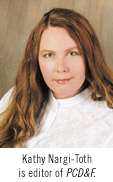
The Oscars came to town on heels of this year’s IPC Apex/Expo trade show. I didn’t stay over, but I heard a few people say they were taking advantage of the timing. For most of us, however, there was already enough going on during the week without the anticipation of a Hollywood finale.
The week got off to a dubious start. On top of the show opening during Chinese New Year, the last day of exhibitor setup was President’s Day – an expensive proposition, as many exhibitors discovered after signing off on back-to-back double time setup charges for Sunday and Monday laborers.
The stage set, there was a lot of grumbling as the show opened but like the good cast members we are, the PCB industry rose to the occasion. By the show’s end, most of us had at least one experience to put a positive spin on the entire week’s events. For those who looked for rays of sunshine, the week turned from trepidation to reward.
There were nearly 450 exhibitors in the combined Apex/Expo exhibit hall. One-third of them were on the Expo (read: bare board) side so there was a lot of ground to cover (assembly equipment and materials vendors occupied the Apex portion of the hall). In our post-show questionnaire we asked 50 of the roughly 150 Expo exhibitors the following questions.
1. Did the show meet your expectations?
2. Was it too short, too long or just right at 3 days?
3. Did you have demonstrations going on at your booth?
4. What is the most important aspect about trade show attendance for your company?
5. Will you be back next year and if so, will you change anything in your approach?
Most exhibitors I spoke with agreed it was a bit slower than previous years on the Expo side of the hall (as of this writing, IPC had not released fabrication-specific attendance figures). As one said, the show has a distinct ebb and flow: “Our expectations for the IPC show have been declining year by year. This really isn’t a very good show for the fab industry. There is a lot of dead time during heavy meeting times. The people coming to the show are mostly from west of the Mississippi, and mostly from California, so the customer cross-section is skewed.”
That exhibitor has a point. The concurrent technical conference doesn’t provide many openings in its programs to foster conference/exhibit crossover. With the notable exception of the hour-long show floor welcome reception on the first night, there was always something else going on from the conference side, detracting from potential exhibition traffic. And at the reception, most people were there for the socializing, food and drinks.
Initial concerns over the new location (the past several years Expo was sited in Anaheim, roughly an hour to the south) proved mostly unfounded. As another exhibitor mentioned, “Overall it met our expectations. We were concerned about the show move, but in the end this proved to be no factor. We’ve seen a drop year-to-year in the number of engineers and managers from individual shops visiting the show. Now only one or two key people come rather than the half-dozen that used to show up.” To this observation I say, we are facing the painful reality of industry “rightsizing.” Most companies now have only a handful of key engineers and decision-makers available to send.
We heard a lot of comments about branding and remaining visible to potential customers: “It’s all about visibility.” “It was quality vs. quantity.” “Keeping your name in the forefront is critical.” “More higher level contacts were made at the show.” “The reality is, you have to be present.” “The quality of our audience this year was better than previous years.” Most exhibitors’ expectations are changing to match the industry transformation around them, it seems.
Of the 28% (14 companies) that officially responded, all said they would be at Expo next year. Almost everyone said they would bring the same amount of resources. One company even said they planned to increase their resource allotment to be better able to cover the show. These thoughts were perhaps best summed by Mark Kannenberg of RBP Chemicals: “I view the show as a very cost-effective way to touch base with our distributors and allied suppliers as well as many of our key customers.” Kannenberg went on to say, “It’s hard to put a number on it, but we’re convinced the investment (in attending the show) is worth it.”
IPC Printed Circuits Expo has at least one more year in Los Angeles, with an option in place for 2009. While the show of today might not win any attendance awards, it remains the most important bare board show in North America.
To see a review of some of the new products featured at the show, go to pcdandm.com/cms/ipcexpo07_productreview.














